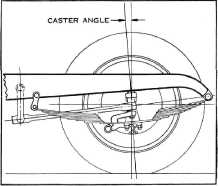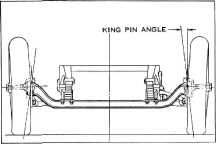1942 - 1947 CHEVROLET SHOP MANUAL
Section 3 - Front Suspension, Axle & Springs
|
|
|||
|
3-14 |
|||
|
|
|||
|
The
steering knuckle arms are installed on the knuckles at an angle, permitting the front
wheels to toe-out when making
turns. This is necessary so
that when turning curves, each wheel may travel in a different arc. This toe-out on curves
is known as steering geometry.
These five
front end factors are built into the axle and must be in proper
relation to each other to prevent
steering faults and excessive tire wear.
CASTER
Caster is
the amount in degrees of the backward tilt of the axle and kingpin, Fig.
31,
A truck without caster would lack
steering stability, would tend to
wander over the road and would
be difficult to straighten out at the end of a curve or
turn. |
under side.
The result would be excessive tire wear on the outer edges of the
tread.
Reverse
camber, or a wheel that is tilted too far in at the top, would result in excessive
tire wear on the inner edges of the tread. The center of the tread
would remain comparatively
unworn. |
||
 |
|||
 |
|||
|
Fig. 32—Camber Angle
The rule is
that if wheels have the maximum of
allowable camber they must have the maximum of allowable toe-in. If wheels have the
minimum amount of allowable
camber they must have the minimum amount of allowable
toe-in.
KINGPIN INCLINATION
Kingpin
inclination is the amount in degrees that the tops of the kingpins are inclined
toward the center of the truck,
Fig. 33. |
|||
 |
|||
|
Fig. 31— Caster Angle
Unequal
caster shows itself in the tendency of the truck to pull to the right or
left. This condition comes about
through the axle having been twisted so that there is a greater amount of
caster in one kingpin than in
the other. The direction in
which the truck will tend to pull is towards the side with less caster. Suppose that an
accident has put a twist into the front axle so that the left side
is zero caster, while the right side
is castered backward five
or six degrees, the right wheel will have a strong tendency to turn inward, pulling
the truck to the left.
CAMBER
Camber is
the amount in inches or degrees that the front wheels are tilted outward at the
top. Fig.
32.
When
a wheel has too much camber, or the wheel is tilted too far out at the top, the
tire is forced by road contact
into a conical shape, on its |
|||
|
Fig. 33—Kingpin Inclination
Kingpin
inclination tends to keep the wheel spindles pointed outward, in line with the
axle, just as caster tends to
keep the wheels of an automobile pointed straight ahead. The effect
is the same, since if the
spindles are kept pointing out at right angles of the truck, the wheels will,
as a result be kept pointing
ahead. It makes the truck steer easier.
We have
already referred to the close relationship between the factors that enter into
the front axle assembly. It is
a point that cannot be over-stressed. One must keep this close
interrelation |
|||
|
|
|||